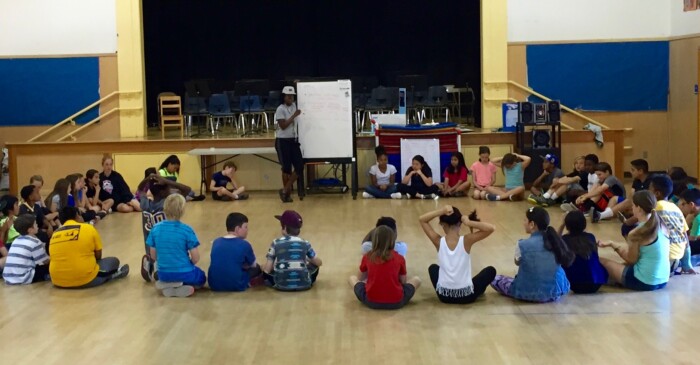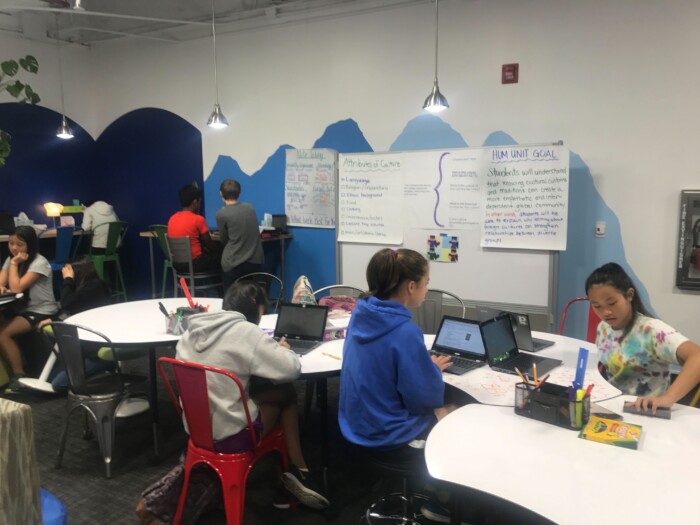-
🏠
-
1
-
2
-
3
-
4
-
5
-
6
-
7
-
1
-
2
-
3
-
4
-
5
-
6
-
7
-
8
-
1
-
2
-
3
-
4
-
5
-
6
-
7

Launching a public microschool requires strategic vision, collaborative leadership, and a deep understanding of the local context. This section of the Public Microschool Playbook offers a roadmap for system leaders and your partners to move from idea to implementation in three phases:
- Planning, which helps teams assess readiness and align around purpose
- Designing, where system leaders define the essential components of the microschool model with stakeholders and partners
- Implementing, which focuses on launching with integrity, learning in real-time, and sustaining success over the long term
Each phase offers guidance, tools, and examples to support bold yet thoughtful action, ensuring that public microschools are built to serve, evolve, and thrive.
Key Features of Public Microschools
Public microschools represent a dynamic approach to education, offering small, adaptive environments that focus on specific educational goals and the needs of a community, which often includes a focused group of students, families, and educators seeking a different kind of learning experience. Crucially, public microschools operate as part of the public education system, ensuring they are accessible to all learners and funded publicly, with no cost to families.
Defining Features of Public Microschools
- Funding: Public microschools are funded via existing per-pupil allocations, providing a tuition-free option for students.
- Size: While there’s no fixed upper limit for enrollment, microschools are defined by their intentionally small design. Most public microschools serve fewer than 150 students (while others as few as 20-25), which enables personalized learning, flexible scheduling, and innovation in both the learner experience and educator roles. While some microschools serve more, what matters most is that these environments are purposefully designed to be small enough to foster strong relationships, learner agency, educator autonomy, and operational agility. As schools grow in size, it becomes more challenging to preserve the flexibility and personalization that are core to the microschool model.
- Governance: Public microschools may operate as standalone schools with their own state-recognized budget codes or as academies within existing schools (often referred to as “school-within-a-school” models). Microschools can be part of a traditional district, exist within a charter school network, or operate under state or tribal authorization. There is also potential for innovative governance structures, such as collaboratives or co-operatives involving local stakeholders, particularly in community-driven or educator-led models.
- Regulatory Considerations: Operating within the public education system, public microschools must adhere to the same regulatory standards as any other public school in their state. This includes compliance with state assessment and accountability requirements, even when microschools adopt innovative instructional approaches. Ideally, microschools can pursue waivers or regulatory flexibilities in areas such as curriculum, scheduling, and teacher certification to better align with their model while continuing to meet state and federal assessment requirements.
Check Out the Workbook!
Are you interested in digging into How to Launch A Public Microschool in Your School System? Make a copy of our workbook, print it out, share it widely with your team.



Planning: Understanding State and School System Conditions
Launching a microschool within a public school system requires a clear understanding of state and system policy conditions and the flexibilities or barriers they create. While system leaders are not policymakers, they must be proficient in navigating regulations, identifying enabling conditions, leveraging existing openings, and advocating for policy changes that support microschool development.
Many states and school systems provide policy openings, such as waivers and exemptions, to create the freedom systems need to develop microschools. Understanding and effectively utilizing these flexibilities is essential for system leaders seeking to establish microschools. You can also learn from the efforts of similar districts and other public school systems in your home state and across the country to reduce frustration and increase the likelihood of a successful launch. Here are some examples of policy enablers that system leaders can access to support innovation in your microschools.
To view full overviews, as well as tips for implementation, for the below recommendations click this link or continue reading and advance to the next page.
Replacing Seat Time with Competency-Based Learning
Traditional funding and accountability systems rely on seat time requirements, which dictate the number of instructional hours students must complete and impact everything from course offerings to bell schedules and hiring decisions. It is now reported that every state offers flexibility through seat-time waivers or competency-based learning policies, allowing learners to progress based on mastery rather than time spent in class. Ohio’s Credit Flex Program was an early example of a statewide policy allowing students to earn credit based on demonstrated proficiency rather than traditional course completion.
Implementing Alternative Accountability and Assessment Models
State accountability systems often dictate standardized testing and reporting. However, some states allow alternative assessments, portfolios, or performance-based evaluations that better align with microschool models. New Hampshire’s Performance Assessment of Competency Education (PACE) is a groundbreaking statewide accountability and assessment system grounded in competency-based learning. In 2023, a network of 20 Missouri school districts requested that the state implement a more responsive assessment system to personalize student learning. The state Board of Education approved “innovation waivers” to allow the districts, now known as the Success-Ready Students Network, to opt out of the traditional state tests for three years.
Expanding Teacher Certification and Staffing Flexibility
Many states require specific certification for educators, but some offer waivers or alternative pathways that allow microschools to staff based on instructional needs rather than rigid credentialing requirements. For example, the Texas Districts of Innovation (DOI) Policy allows districts to waive certain certification requirements, giving microschools within public districts more flexibility to hire industry experts and community educators.
Exploring Additional Waivers and Exemptions
Similar to the assessment waivers described above, many states offer waivers that allow public school systems to modify traditional regulations in exchange for implementing innovative practices across various dimensions of teaching and learning. For example, Georgia’s Charter Systems Initiative currently has nearly 50 participating districts that waived specific state regulations, giving them more autonomy in curriculum design, staffing, and assessment models to support alternative learning environments like microschools.
Adapting Nontraditional Facilities for Microschools
Zoning laws and school facility requirements can impact where and how microschools operate. Some public school systems utilize community spaces, such as libraries, museums, or co-working spaces, to create cost-effective learning environments. For example, in Michigan, public school districts can utilize nontraditional facilities for educational purposes, provided these facilities comply with state building codes and regulations. The Grand Rapids Public Museum School, part of the Grand Rapids Public Schools, is located within a museum.
Aligning with Statewide Learner Profiles & Portraits of a Graduate
As more states shift graduation requirements to better align with community and workforce needs, public school system leaders can align microschools with these updated learner profiles, often referred to as a Portrait of a Learner or a Portrait of a Graduate. At least 20 states and hundreds of school systems have developed portraits and profiles. For example, the Portrait of a Nevada Learner is framed as a set of reflection questions for learners about growing, contributing, and making an impact.
Navigating State and Local Policy Resources
Public school system leaders do not need to rewrite policy to launch a successful microschool; however, they must understand how to navigate existing conditions and leverage available flexibilities. By identifying regulatory openings, forming strategic partnerships, and advocating for necessary adjustments, you can create microschools that align with your community’s needs while remaining compliant with state and system regulations.
Funding is a key consideration in this work. Federal funding streams—such as Title I, Title II, Perkins, and IDEA—often allow for more flexibility than states typically apply. For example, Section 1003A of the Every Student Succeeds Act (ESSA) allows states to reserve up to 3% of their Title I allocation for Direct Student Services. These funds can be used to expand access to advanced coursework, Career and Technical Education (CTE) pathways, credit recovery, dual enrollment, and personalized learning options. Yet very few states have taken advantage of this flexibility. System leaders and state partners can collaborate to unlock these underutilized resources, thereby supporting the design of microschools.



Designing: Defining and Establishing Key Components
Designing a microschool is both a creative and strategic endeavor. It begins by translating a broad vision into a cohesive, actionable plan that aligns your learning model, staffing, funding, and operations. This phase is about making foundational decisions that will shape the learner and educator experience from day one. These decisions must reflect your community’s values, needs, and aspirations. While every microschool will look different, successful models share a common trait: intentional design rooted in clarity of purpose.
System leaders are uniquely positioned to create microschools that challenge traditional assumptions and reimagine what school can be. But innovation doesn’t mean starting from scratch. It means thoughtfully assembling the right components—from instructional models to operational logistics—to serve a defined learner population in a focused, personalized way.
Each element in this section is structured to guide you through a core component of microschool design. For every topic, you’ll find a brief explanation of why it matters, a set of guiding questions to focus your planning, a list of action steps to move your work forward, and tips and examples drawn from real-world microschool efforts. Where relevant, we also highlight additional considerations related to opportunity and access, showing how your design decisions can influence who your microschool serves and how it contributes to the broader system. Taken together, these resources are meant to help you move from idea to blueprint with purpose, clarity, and confidence.
Clarify Your Vision and Purpose
A clear, system-level vision is crucial for a public microschool as it guides all design decisions. The specific goals of the microschool, such as retaining current students or attracting former students, will significantly impact how funding is approached and the overall design. For example, offering more college courses will lead to a different design than focusing on personalized learning for under-credited students. A vision may have multiple facets, such as retaining students by providing a personalized environment. The design process will constantly refer back to this core purpose to prioritize elements and ensure alignment. Ultimately, the microschool’s purpose acts as a “North Star,” guiding all aspects of its development and implementation.
Make the Case: Financial Feasibility and Return on Investment
Launching a microschool requires determining financial feasibility and justifying the investment. Unlike traditional school planning, microschool funding balances short-term startup needs with long-term strategic value. These models strengthen public systems by attracting/retaining students, piloting innovations, and building trust. Funding can come from existing resources, philanthropy, or per-pupil funds. Developing a multi-year ROI theory is vital, considering both financial and non-financial value. Early ROI might include increased enrollment or learner engagement, justifying deeper investment and scaling.
Design Your School Structures
Creating your unique identity as a microschool and developing key school structures that enable learner-centered learning can drive what makes your microschool special and how it will contribute to scaling learner-centered practices within your system.
Align Your Vision With Your Learning Model
A key reason for increasing accessibility to public microschools is to provide students with more flexible and personalized learning environments. The more these lean away from traditional approaches in favor of more “21st-century” ones, the more likely they will prepare learners for an uncertain future. Given this, your school’s academic model—including curriculum, instruction, and assessment—is critically important.
Identify Funding: Budget and Cash Flow
Designing a microschool is not just an instructional challenge; it is also a logistical one. It’s a financial one. Even the most compelling vision requires a clear, realistic plan to fund the early development and launch stages. While many school system leaders focus on long-term funding models, microschools also require up-front investments: time to plan, personnel to lead design work, and often seed capital to begin operations before per-pupil dollars arrive.
It’s also critical to look beyond the budget and consider cash flow. Many grants, reimbursements, or school system budget allocations are not timed to match monthly or bi-weekly expenses, such as payroll. Without a strong cash flow strategy, even well-funded schools can run into solvency issues. Launching a microschool requires aligning your resources, timelines, and payment structures to ensure money is available when it’s needed. Getting this right increases your chance of a smooth launch and builds trust in the microschool’s viability from day one.
Navigate Governance and Accountability
To innovate within a public school system, you must comply with federal, state, and system policy. Policies will differ based on your governance model (e.g., district public, charter, public-private partnerships). Because microschools are intended to be nimble, innovative, and learner-centered, they benefit from the most significant degree of autonomy the system can provide. You and the person or team responsible for preparing the system for a public microschool must be well-versed in all policies and requirements, as well as the workarounds that may grant you the autonomy needed for your school to thrive.
Solidify Staffing
Plan for Operations and Facilities
Microschools serve a smaller number of students and are therefore more nimble than larger or more traditional schools. Their size offers opportunities for flexibility, particularly in finding affordable and safe spaces that align with the learning vision. Co-location with existing schools or partner facilities can be a cost-effective solution, especially in the early stages, but it also has trade-offs. Leaders must be intentional about maintaining the microschool’s distinct culture, strategy, and identity to prevent it from being negatively altered by the host, especially when the co-location host is another school. Careful planning around operations and facilities can help ensure that efficiencies don’t come at the expense of innovation and autonomy.



Implementing: Launching and Sustaining the Microschool
Designing a microschool requires courage, clarity, and collaboration. While the process involves practical decisions around staffing, funding, governance, and instruction, it ultimately creates the conditions for meaningful, learner-centered experiences. Thoughtful design lays the groundwork for everything that follows. By investing time and energy into these foundational components, you’re not just preparing to launch a new school; you’re creating a model that can inspire broader transformation across your public school system and beyond.
Once the core design of your microschool is in place, the real work begins: launching, learning, and sustaining. Implementation is not a single event—it’s a process of activating your design, responding to real-world conditions, and building the relationships and routines that make your vision come alive. In this phase, leaders must balance urgency and patience: you’re working toward transformation, but with the understanding that success will come through iteration, not perfection.
Microschools thrive when leaders create space for continuous learning, not just for students but also for educators, families, and the system itself. Implementation is your opportunity to test ideas, center the voices of those most affected, and develop the conditions for long-term success. From student enrollment to educator support, from early feedback loops to scaling strategy, this section equips you to move from startup to sustained impact with clarity, adaptability, and purpose.
Recruit and Enroll Students
Public microschool enrollment involves several key factors: defining service area (geographic, system-wide, or beyond), aligning with existing enrollment processes and timelines, setting student numbers, identifying special populations, considering transportation, and marketing. Thorough planning ensures families are informed, can make decisions, and understand the application process.
Establish a Strong Culture and Launch Experience
Support Educators and Ongoing Professional Learning
Microschool educators have diverse responsibilities, including designing learning, building relationships, problem-solving, and operations. Effective professional learning for them should be intentional, embedded, and aligned with the school’s values and model. Microschools can shift from traditional professional development to cultures of inquiry, reflection, and collaboration. Investing in ongoing educator development through routines, coaching, and community support ensures educators grow alongside students and enables microschools to fulfill their promise of innovation and teacher empowerment.
Lead for Continuous Improvement and R&D
Public microschools serve as valuable R&D spaces for school systems. Their small size and flexibility allow for the testing and refinement of new educational approaches. These innovations can lead to practices adopted by other schools or the development of entirely new models. Continuous improvement through feedback and iteration is essential for microschools to thrive and contribute to broader system transformation, ultimately fulfilling their promise as engines of innovation.
Scale and Sustain the Model
Microschools can have a significant impact despite their small size. They can drive broader system change by pioneering new practices or providing evidence of effective alternative approaches. Some microschools may remain unique to their context, while successful designs may be adapted and replicated. Systems can also scale by expanding the number of small, agile learning environments. The right path depends on various factors, and sustainability involves planning, funding, and policy conditions. Documenting and sharing lessons learned is crucial for others to benefit.
Build For Long-Term Financial Stability
Microschools need long-term sustainability beyond initial funding. This means operating within public funds, managing costs, and adapting to changes. Viability ensures credibility with stakeholders and establishes the microschool as a lasting part of the public education system.
Stregthen Community and Ecosystem Partnerships
Microschools thrive with strong community ties. Partnerships enhance student experiences, provide resources, and extend learning beyond the school. Community involvement, including internships and support services, strengthens sustainability and relevance